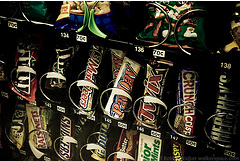Smackdown On Snacktime: Gov’t Sets Rules On Junk Food Sold In Schools
In high school, you were lucky if your study hall period was held in the cafeteria. Because that meant access to the vending machines full of junk food. There was nothing we liked more than a good sugar buzz going into Mr. B’s geometry class, let me tell you. Those days will be no more for schools starting in the 2014-2015 school year, however, as the government’s new “Smart Snacks in Schools” program kicks in.
The program outlines nutrition standards for what the feds call “competitive foods.” That essentially means any food sold at the school that isn’t a part of the regular meals. The new rules have limits for calories, fat, sugar and sodium.
That means no more high-fat chips, candy bars or full calorie sodas. Instead, vending machines and a la carte lines will feature items like no-calorie flavored water, low-fat popcorn and granola bars, reports USA Today.
The rules won’t apply to after-school events, concessions stands or the foods kids bring in their lunches or for classroom parties, as well as other school celebrations. So no, you won’t have to figure out how to make quinoa cupcakes for your kid’s birthday party.
“It’s great to be one step closer to getting junk food out of schools,” says Margo Wootan, director of nutrition policy for the Center for Science in the Public Interest.
All competitive foods must:
— Have no more than 200 calories for snacks and side dishes; and no more than 350 calories for entrees that are not part of the school-meal program.
— Meet requirements for fat, saturated fat and sugar. They can contain no trans fat. Some exceptions on the fat limits will be allowed for foods such as reduced-fat cheese and nuts.
— Be either a fruit, a vegetable, a dairy product, a protein food, a whole-grain-rich grain product or a combination food that contains at least ¼ cup of fruit or vegetable. For the first two years after the standards go into effect, foods can qualify as a competitive food if they contain at least 10% of a nutrient that’s been designated as public health concern for children such as calcium, potassium, vitamin D or fiber.
All schools can sell water or carbonated water; unflavored low-fat milk; flavored or unflavored fat-free milk and soy alternatives; 100% fruit or vegetable juice, but there’s a prohibition against regular-calorie sports drinks.
“Eventually all school foods will have to contain real food — fruit, vegetable or other healthy food component,” Wootan says. “Companies won’t be able to just fortify snacks with cheap nutrients and then sell them in schools as healthy.”
Previously: Study Says Restricting Junk Food In Schools Could Help Slow Child Obesity Rates
Junk food getting canned in schools [USA Today]
Want more consumer news? Visit our parent organization, Consumer Reports, for the latest on scams, recalls, and other consumer issues.


